You are here
Key Drivers of the National Debt
America’s unsustainable fiscal outlook is the result of a structural mismatch between the amount of revenues that the federal government collects and the amount of spending promised under current law. Federal spending — driven by rising healthcare costs, demographics, and interest payments on the national debt — is paired with revenues that are insufficient to meet the commitments that have been made.
MISMATCH BETWEEN SPENDING AND REVENUES
While the COVID-19 pandemic exacerbated an unsustainable fiscal trajectory, the national debt was already growing because of a fundamental imbalance between spending and revenues that will continue to grow in the future. The Congressional Budget Office (CBO) projects that federal spending will climb from 23.1 percent of gross domestic product (GDP) in 2024 to 27.9 percent by 2054; that growth is largely due to spending on healthcare and retirement programs for elderly Americans along with rapidly growing interest costs. Revenues, on the other hand, are only projected to climb from 17.5 percent of GDP in 2024 to 18.8 percent in 2054.
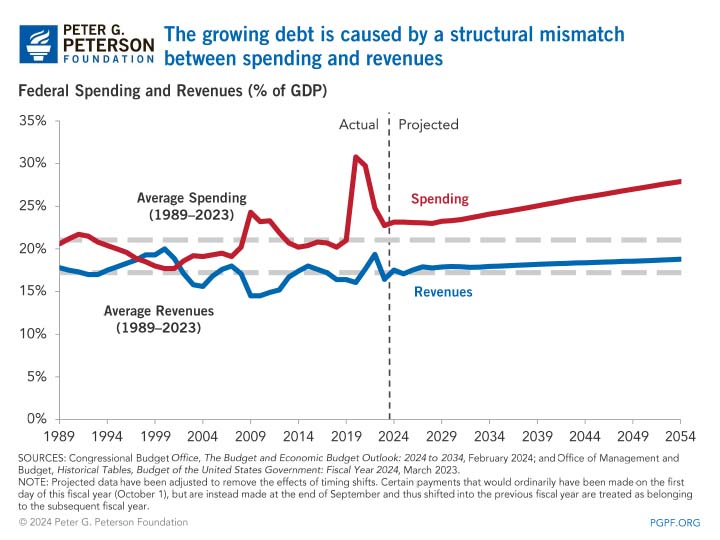
HEALTHCARE COSTS
One of the primary drivers of America’s long-term fiscal challenges is our inefficient healthcare system. Combined with the demographic realities of an aging population, America’s healthcare system leaves us with an unsustainable fiscal future. Not only will more Americans qualify for federal healthcare programs like Medicare in the coming years, but older people, on average, need more healthcare. Consequently, without reform, the federal budget will bear the cost of rapidly growing healthcare bills.
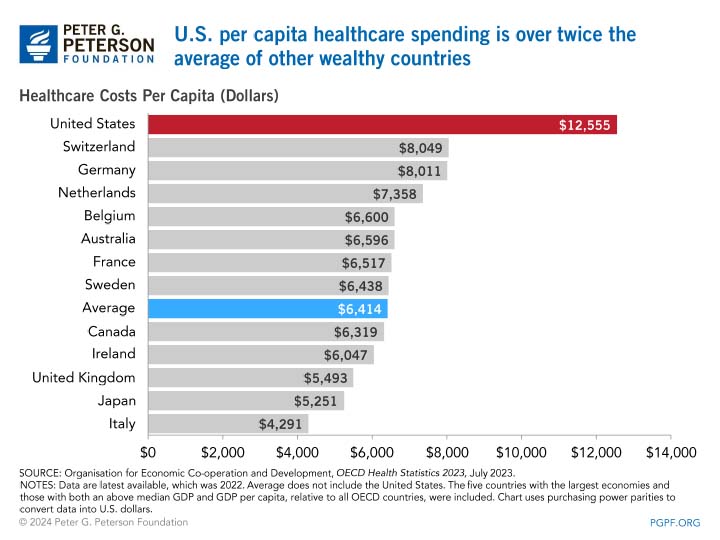
In 2022, the United States spent $4.5 trillion — or 17 percent of the national economy — on healthcare. On a per capita basis, our healthcare system is the most expensive among other wealthy countries. Yet, America’s health outcomes are generally no better than those of our peers, and in some cases, are worse, including in areas like life expectancy, infant mortality, asthma, and diabetes.
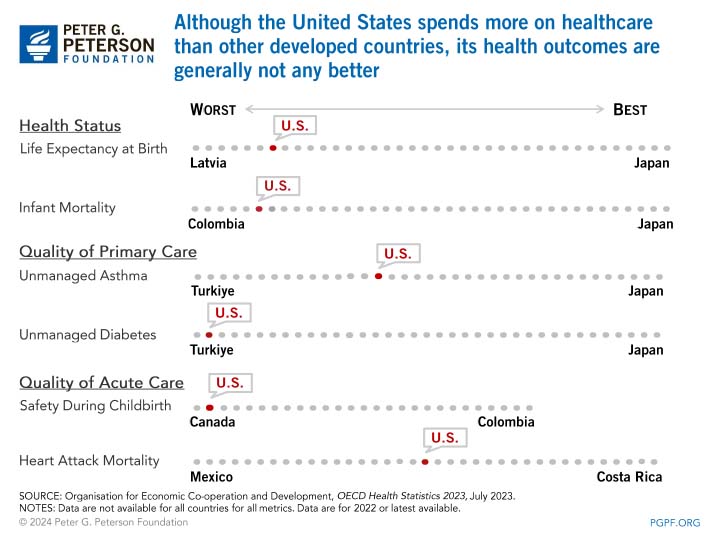
Put simply, we are paying more than other countries, but we aren’t seeing better results. Healthcare experts have estimated that 25 percent of our total healthcare spending goes to unnecessary and wasteful services. Furthermore, healthcare spending is projected to keep rising — faster than inflation, wages, and the overall economy. Not only does the system result in health outcomes that are generally no better for patients, but its inefficiency also creates enormous challenges for the U.S. economy and federal government.
The primary reasons why our healthcare system underperforms is because the typical factors that fuel improvement and innovation in other industries are lacking in healthcare:
- Historically, consumers have not been cost sensitive because their employers and health plans often cover a large share of their costs and because they lack the information required to assess quality and cost.
- Employers and insurers often assume a passive role, accepting annual cost increases and eventually passing those costs on to customers and employees.
- Providers generally operate under a fee-for-service model in which they are compensated based on the volume of their services rather than the value of the care they provide.
- Improvements in technology often make healthcare more expensive.
Under this system, the demands and rewards for quality, efficiency, and price sensitivity are sharply reduced.
The growth in healthcare costs per person has slowed in the last few years, but it is uncertain how long this welcomed trend will continue. Despite the slowdown, the Centers for Medicare and Medicaid Services projects that total spending for healthcare will climb to 19.6 percent of GDP in 2030. According to CBO, spending on the major federal healthcare programs will rise from 5.6 percent of GDP in 2024 to 8.5 percent in 2054 — an increase of about 52 percent.
DEMOGRAPHICS
Over the next 25 years, another major driver of rising long-term federal spending is the aging of America’s population, as the number of people aged 65 or older will increase much faster than the working-age population. The aging of the baby-boom generation (those born in the post-World War II period of 1946 to 1964), as well as increases in life expectancy, drive the increase in the number of older Americans.
Baby Boomers
The first wave of baby boomers turned 65 in 2011, and the number of people over that age will climb by about 24 million from 2022 to 2050. Meanwhile, the number of people age 20 to 64 will increase by only 18 million people over the same period, according to the Social Security Trustees Report.
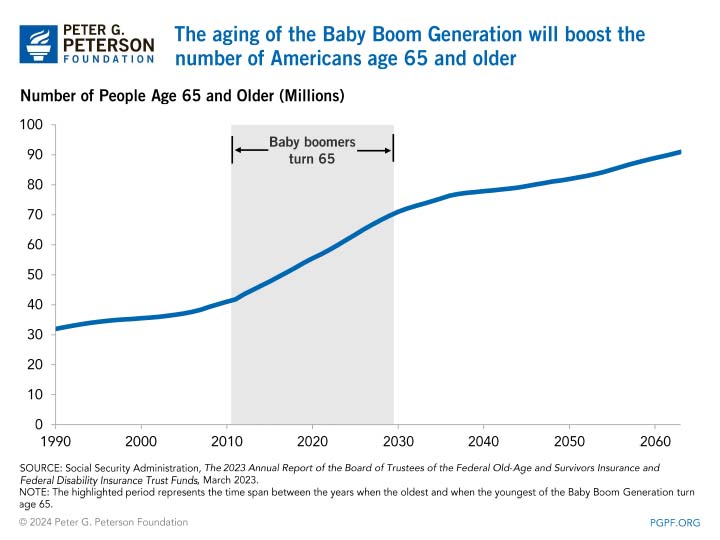
Increasing Longevity
Not only will the number of older Americans increase, but they are also expected to live longer in retirement. Overall, life expectancy among Americans who live to age 65 has risen significantly over the past several decades. As those aging and longevity trends continue, the number of people age 85 and older is expected to almost triple from 2024 to 2054, according to CBO.
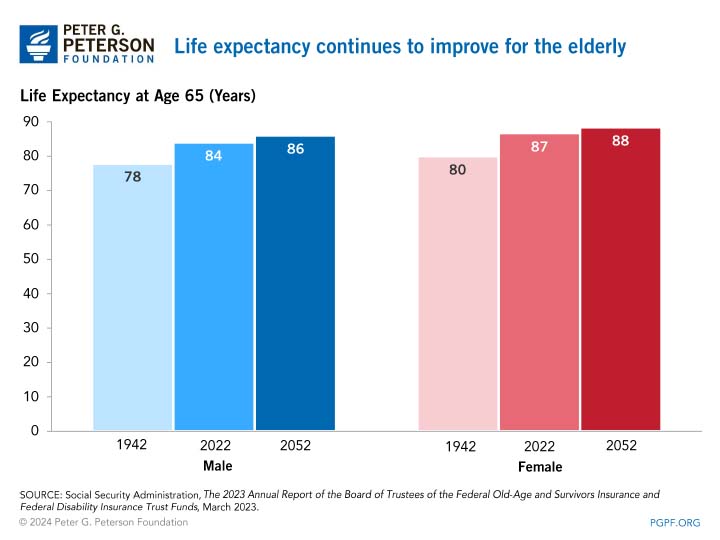
It is great news that Americans are living longer, and the retirement of the baby-boom generation comes as no surprise. However, those trends mean that the government will spend more on programs that serve this growing population of older Americans. In fact, spending on Social Security and the major health programs (which includes Medicare, Medicaid, the Children’s Health Insurance Program, and subsidies to purchase health insurance) accounts for all of the increase in federal non-interest spending relative to the size of the economy over the long term.
Such demographic trends are already putting pressure on the federal budget — threatening the sustainability of vital programs benefitting older and vulnerable Americans.
NET INTEREST COSTS
As the national debt grows, so too can the cost of servicing that debt. Not only can net interest costs crowd out opportunities to invest in other areas of the economy, but they also play a sizable role in the growth of federal spending.
Interest costs are the fastest-growing “program” in the federal budget — exceeding the growth of Social Security and Medicare — and will total $12.4 trillion over the next decade, according to CBO. Furthermore, such costs crowd out the nation’s ability to invest in other programs that are vital for our future, such as education, transportation, and research and development.
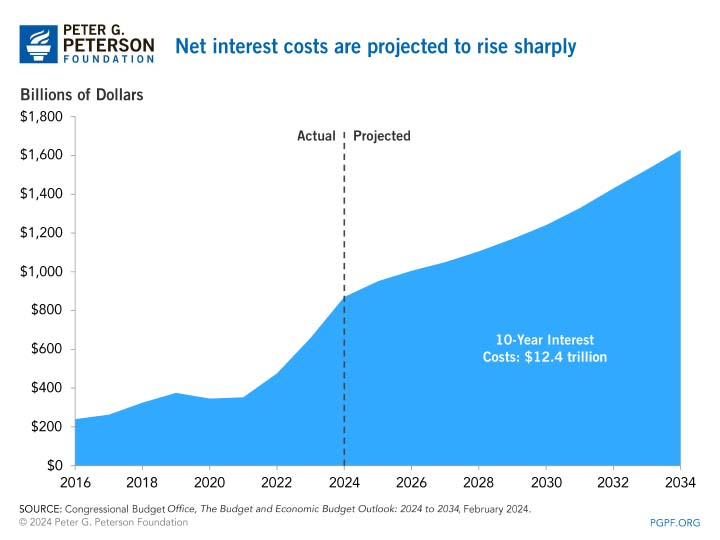
INSUFFICIENT REVENUES
It would be one thing if our tax code were designed to fund all the promises we’re making, but it’s not. The U.S. tax system does not generate enough revenues to cover the spending levels promised.
Our tax code is also overly complex, confusing, inefficient, and unfair. For example, it remains riddled with tax expenditures, or “tax breaks,” that provide financial benefits to specific activities, entities, and groups of people. Those tax breaks, which totaled $1.8 trillion in 2023, increase annual deficits and can create market distortions that are damaging to economic growth and productivity.
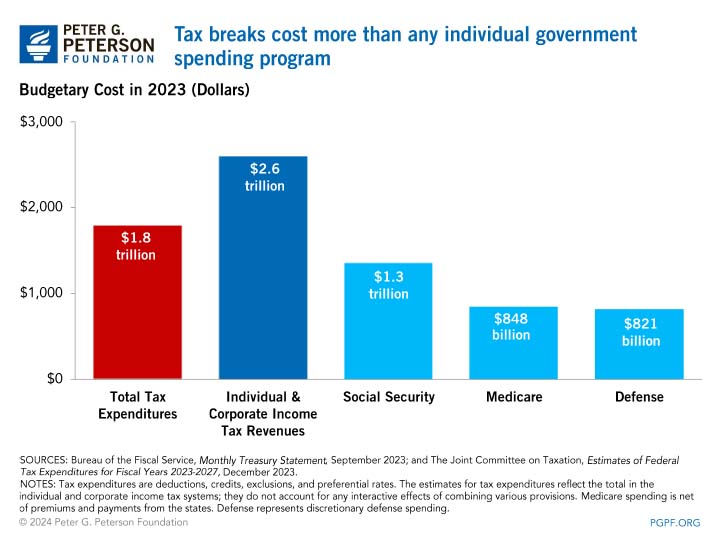
Improving our fiscal outlook means addressing the structural imbalance between revenues and spending. Understanding the key drivers of the national debt — including our changing demographics, rising healthcare costs, interest payments on the debt, and an insufficient revenue base — is crucial to resolving our fiscal imbalance and improving our fiscal trajectory.
